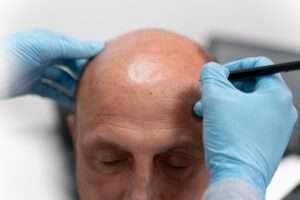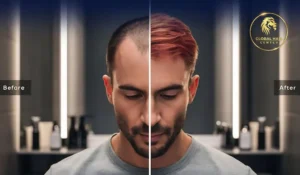Breaking Myths: Debunking Common Misconceptions About Hair Transplants

Breaking Myths About Hair Transplant Procedures
Hair loss can be a distressing experience, impacting one’s self-esteem and confidence. Fortunately, advancements in hair transplant techniques offer effective solutions for restoring natural hair growth.
However, misconceptions and myths about hair transplants often deter individuals from considering this transformative procedure. This blog aims to dispel common myths about hair transplants and provide accurate information to help you make informed decisions about your hair restoration journey.
Hair Transplants Look Unnatural
One of the most prevalent myths about hair transplants is that they result in an unnatural appearance. This misconception often stems from outdated techniques that use large grafts or improper placement. Modern hair transplant methods prioritize natural-looking results, such as Follicular Unit Extraction (FUE) and Follicular Unit Transplantation (FUT). Skilled doctors place individual follicular units to mimic natural hair growth patterns, ensuring a seamless transition with existing hair.
Hair Transplants Are Painful
Another common misconception is that hair transplant procedures are highly painful. In reality, advancements in anesthesia and surgical techniques have significantly reduced discomfort during and after the procedure. Local anesthesia is administered to numb the scalp, ensuring a painless experience during hair follicle extraction and transplantation. Patients may experience mild discomfort or soreness post-procedure, which can be managed with prescribed medications and proper care.
Hair Transplants Are Only for Men
While male pattern baldness is widely known, hair loss affects both men and women. Many women experience hair thinning or pattern baldness due to genetics, hormonal changes, or medical conditions. Hair transplant procedures are effective for both genders, with tailored approaches to address specific hair loss patterns and aesthetic goals. Female Hair Transplantation techniques ensure natural-looking results, restoring confidence and hair density for women.
Hair Transplants Are Expensive and Inaccessible
Cost concerns often discourage individuals from considering hair transplant procedures. However, the idea of hair transplants being extremely expensive is a myth. The cost of a hair transplant varies based on factors such as the extent of hair loss, transplant technique, clinic location, and doctor expertise. Many clinics offer financing options or flexible payment plans to make hair transplants more accessible to a wider range of individuals.
Hair Transplants Require a Lengthy Recovery Time
Contrary to popular belief, modern hair transplant techniques offer relatively quick recovery times. Patients can typically resume normal activities within a few days to a week post-procedure, with minor restrictions to protect the newly transplanted hair follicles. Visible hair growth starts within a few months, gradually improving over time to achieve fuller, natural-looking results.
Hair Transplants Are Not Suitable for Ethnic Hair Types
Another misconception is that hair transplants are not effective for individuals with specific ethnic hair types, such as curly or coarse hair. Skilled hair transplant doctors are experienced in working with diverse hair textures and characteristics. Customized approaches, including specialized extraction and implantation techniques, ensure successful outcomes for individuals with varying hair types and qualities.
Hair Transplants Are Risky or Unsafe
There is an idea that hair transplant procedures are risky or unsafe. In reality, when performed by a skilled and experienced doctor in a reputable clinic, hair transplants are safe and minimally invasive. Clinics adhere to strict safety protocols and standards to ensure patient well-being throughout the procedure and recovery process. Complications are rare, and patients are carefully screened to determine their eligibility and manage expectations regarding potential risks.
Hair Transplants Are Not Permanent
Some individuals believe that hair transplants provide temporary results and that transplanted hair may fall out over time, this is not true. Hair follicles extracted from donor areas, such as the back or sides of the scalp, are genetically resistant to hair loss. When transplanted to balding or thinning areas, these follicles continue to grow naturally, providing permanent hair restoration. It’s important to note that while transplanted hair is permanent, existing hair may still be susceptible to further hair loss due to genetic or other factors.
Hair Transplants Are Noticeable or Require Special Care
Concerns about the visibility of transplanted hair or the need for extensive maintenance are common myths. Modern hair transplant techniques ensure natural-looking results, with transplanted hair blending seamlessly with existing hair. Patients can style and care for their transplanted hair just like natural hair, without the need for special products or treatments. Following post-operative care instructions and regular follow-ups with your transplant specialist contribute to optimal results and hair health.
Hair Transplants Are Only for Extensive Baldness
While hair transplants are effective for advanced stages of hair loss, they are also suitable for individuals in earlier stages of hair thinning or pattern baldness. Early intervention with hair transplants can prevent further hair loss progression and restore hair density, providing natural and aesthetically pleasing results. Consulting with a hair transplant specialist allows for a personalized assessment of your hair loss stage and appropriate treatment recommendations.
What Actually Happens During Hair Transplant Procedures?
Delving into the scientific principles behind hair transplant procedures can provide a deeper understanding of its effectiveness and long-term outcomes. The concept of donor dominance, where transplanted hair follicles are genetically resistant to baldness ensures lasting results. Advanced tools such as microscopes and precision instruments enable doctors to extract and implant follicular units with great accuracy, contributing to natural hairline design and overall aesthetic appeal.
Emotional Journey of Hair Loss and Restoration
Hair loss can have profound emotional effects, impacting self-confidence, social interactions, and quality of life. Discussing the emotional aspects of hair loss and restoration can offer support and reassurance to individuals considering hair transplant procedures. Patients mention that the hair restoration experience and its psychological effects are extremely beneficial as it helped them regain their confidence and social interactions.
Highlighting Industry Innovations and Research
The field of hair restoration continually evolves with technological advancements, research breakthroughs, and innovative techniques. Discussing the latest industry trends can showcase the ongoing commitment of hair transplant centers to excellence and patient satisfaction. From robotic-assisted hair transplants to bio-enhanced growth factors, this field is full of new techniques to help individuals seeking effective hair loss solutions.
Conclusion
Understanding the truth behind common myths about hair transplants allows individuals to explore effective solutions for hair loss confidently. Modern hair transplant techniques offer natural-looking results, minimal discomfort, and quick recovery times, making them suitable for a diverse range of patients. Breaking through misconceptions opens doors to renewed self-esteem, confidence, and a fuller head of hair. If you’re considering a hair transplant, consult with a reputable hair transplant center to embark on your journey toward hair restoration and renewed confidence.

Empower Your Look: Women’s Eyebrow Transplants.
In the cosmopolitan city of Dubai, where beauty meets innovation, women are embracing eyebrow transplants as a transformative solution to.
Read More
Hair Transplant in Installments in the.
Hair loss affects millions of men and women worldwide, impacting confidence, appearance, and quality of life. In the UAE, where.
Read More

